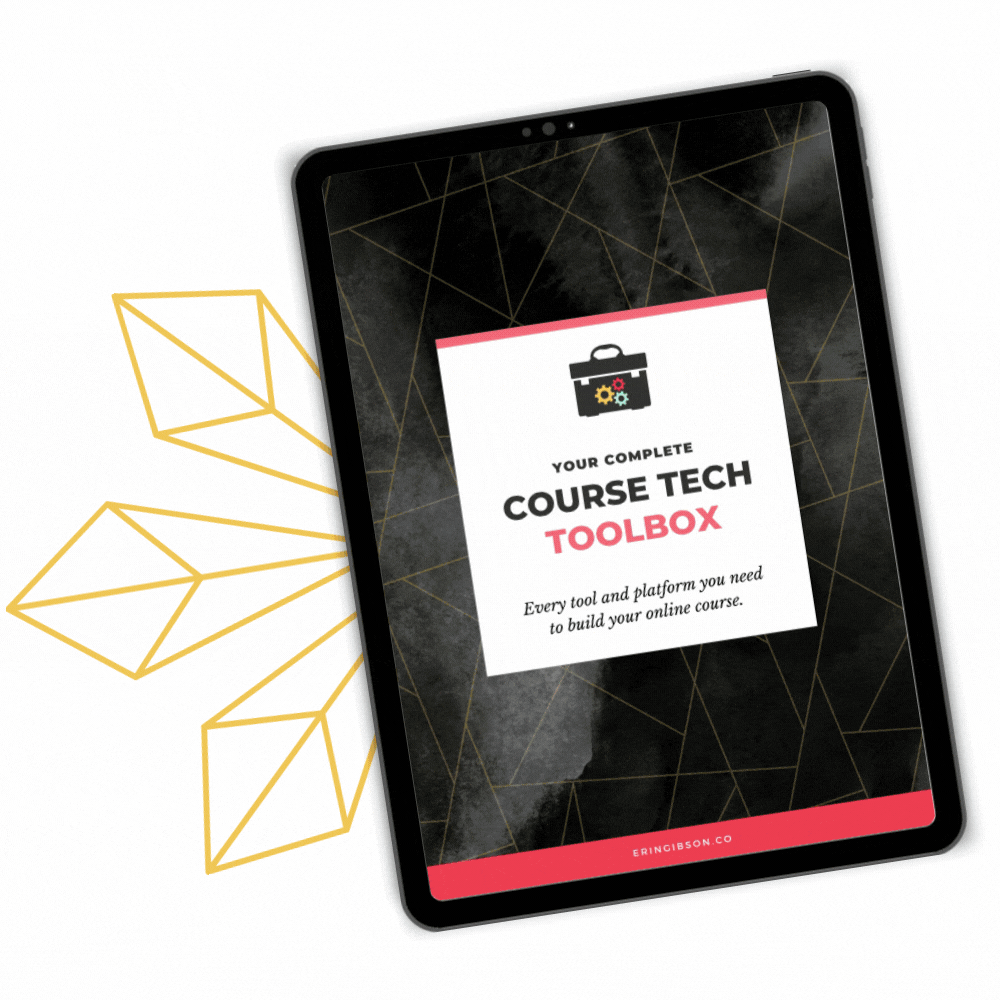You create an amazing online course and you jam it full of all of your knowledge and best tips and tricks and sprinkle in so much love. Creating courses is not for the faint of heart. I don’t care if you’re teaching accounting or knitting. They’re full of blood, sweat, tears, and love.
You open the cart. You email your list. You blast it out on social media. You’ve got a great lead magnet, or maybe even some ads driving traffic. You’ve ticked all the boxes and the traffic is flowing.
And then that thing, that beautiful course that you’ve slaved over for months, has the nerve to just lay there like a dead stick and not friggin’ sell.
Crickets. Conversion rate: NOPE%
It’s a gut punch.
Many clients come to me with fully built online courses thinking that the whole thing needs to be retooled and redesigned because it’s not selling. So I roll up my sleeves and I get in there and I actually look at the thing. And it’s a really, really good course.
There are several reasons this can happen:
- You neglected to build your audience.
- You’re not driving enough traffic to your sales page.
- Your audience doesn’t actually want your course.
“But none of those things are true!” you scream into the night.
Okay, I believe you. So then we’re left with the most common reason:
- Your sales page sucks.
Bad sales pages are the death of great online courses. No one wants to eat in a restaurant that looks like it should be shut down by the Health Department, no matter how incredible the food is!
If you’ve created an online course and it launched to a nice, crisp bellyflop even though, by all rights, that thing should be selling… the first thing you should do is reevaluate your sales page.
These are some sales page mistakes I see over and over again that will kneecap your course sales.
1. You’ve erected a massive wall of text between your customer and the purchase.
In the social media age, our attention spans are getting shorter and shorter. You need to hook your viewer quickly, and that means no giant walls of text.
- Paragraphs should be short and easy to skim. Ideally, no more than 3 or 4 short sentences or 5 lines deep on the page.
- Use bullets and bold text to emphasize important points.
- But don’t overdo it! When everything is bold or in CAPS it all blends together and nothing registers as important.
- Break up your text with photos, icons, or other graphical elements.
Even if your copy is laid out and formatted well, you may be seriously overestimating how much your customer is willing to read and overwhelming them with the sheer volume of content.
“If it is possible to cut a word out, always cut it out.”
– George Orwell
I read a lot of sales pages (for science!) and one thing I see so often is a dense, meandering narrative that says the same thing over and over again. Frankly, it makes my eyes glaze over.
There are certain crucial pieces of information (expected results, for example) that you’ll want to talk about more than once on your sales page but make sure you’re not beating a dead horse. If you’ve got the same idea restated in six ways, chances are that only two of those statements are actually super effective and punchy.
The price and size of your course or product will determine how much text you need to sell it. While every course or product is unique, here are a few guidelines for how many words to shoot for on your sales pages and landing pages:
Free Lead Magnet = 500 words or less.
Seriously, we don’t need much copy here—just a few bullets about what they’re going to receive will do! A simple PDF lead magnet needs around 100 words or less, while something like a free challenge or webinar might take a little more.
To give you an example of what this looks like, the landing page for my Course Tech Toolbox is only 50 words!
Smaller course or inexpensive digital product = 500-2000 words.
We want to hook the reader with the value in this smaller product or mini-course and get a quick “Yes!” Too much sales copy can actually slow that process down and make your reader feel like there’s a lot they need to understand before they sign up when, in reality, it’s a very simple offering. Don’t make it seem more complicated than it is!
For example, this sales page for Sarah Von Bargen’s No Grocery Challenge Ebook is about 550 words, while this sales page for her Bank Boost course is about 2000 words.
Full-length course or larger digital product = 2000-4000 words.
Here we need more details to thoroughly explain what the reader will receive for this higher price tag. There’s going to be more description of the specific components, more on the features and benefits, more examples and storytelling, more testimonials… more of everything.
To give you an example of what this looks like, the sales page for my Launch with Asana course is about 3300 words.
Is there ever a reason to have more than 4000 words on your sales page? I won’t say never, but I will say that I’ve yet to see a 5000-word sales page that wouldn’t be more effective as a 4000-word sales page. 😉
Do this right now:
Go to your sales page, do a Select All, and copy the text. Paste it into a Google Doc, and then go to Tools > Word count.
If your sales page is way over the estimates above, take a look and make sure all of that copy is absolutely critical. See if you can trim down any fluff or redundancy.
2. They can’t see themselves (or their sweaty palms) in the story you’re telling.
When someone lands on your sales page, you want them to scream “OMG THAT’S ME!!!”
They need to be shown that you understand them, their struggles, that you’ve been there and GET why it’s so hard, and most importantly, that you have a f’ing solution for them.
Rather than just promise a result, promise a result + alleviate a fear.
Which one of these feels more relatable?
Learn to speak confidently on stage and captivate your audience!
OR
Learn to speak with authority and own the room, WITHOUT sweating through your shirt, turning red as a tomato, or sounding like an awkward kid giving a book report.
See the difference?
In the first one, you’re telling them what you’re going to teach them.
In the second one, you’re telling them what you’re going to teach them PLUS you’re painting a picture of how you’re going to make them actually feel better. You’re not selling a result, you’re selling the way that result makes their life better. So what does that part look like?
Your reader is over there envisioning their sweaty armpits on stage and thinking “Oh man, I TOTALLY get all squirrelly and weird JUST LIKE THAT when I have to talk in front of people. She gets me.”
Which one of these feels more relatable?
I will teach you to rock your Facebook ads and convert more customers!
OR
I’ll show you how to cut through the tech jargon and geek-speak and understand Facebook ads with a simple, repeatable process for creating ads that sell your products every time.
In this one, rather than just promising your viewer AWESOME ADS (barf), you’re addressing the fact that Facebook ads can be intimidating and confusing to set up properly, and promising to demystify the process and make it easy for your audience to understand and do it successfully.
3. You’re not telling them what to expect and the details are… fuzzy.
More than anything (even more than cheap booze and free pizza) people want to feel safe and secure about how they spend their money. They want to know that they’re making a smart decision. And in order to feel secure, they need to know exactly what’s going to happen and what they’re going to get.
So what’s going to happen after they click Buy Now?
Imagine that a new restaurant opens near you advertising “The best Norwegian food in town!” Hm, Ok. You don’t know what Norwegians eat, but it sounds interesting!
You google it up. They have a beautiful website that prominently features the life story of the adorable Norwegian owners, Anders and Astrid. But there’s no menu. It doesn’t say what the hours are. It doesn’t say if it’s dine-in, delivery or takeout. There’s no phone number. Are you tripping over yourself to run right over there and check this place out?
I’m not. It might be a complete waste of my time.
I see this over and over on sales pages for courses. I’m reading all this wonderfully descriptive narrative about how something is going to change my life. They may even have lovely testimonials from happy customers affirming that “YES, THIS SHIT DID INDEED CHANGE MY LIFE.”
But I can’t figure out what it actually IS or what is IN IT. What am I paying for? What am I getting? Is it a self-paced course? Will I interact with other students? Is it video or text? How long will it take me?
Your sales page should always have:
- A list of what they get in plain terms – How many videos are in it? How many hours of video? Is there a workbook? Worksheets? Is there an opportunity for live Q&A or a Facebook group for support? Give them a nuts-and-bolts explanation of what they’re actually buying.
- An explanation of what happens next – When I purchase, do I get access to everything immediately? Is the file emailed to me to download? Does the course start on a certain date? Can I get into the Facebook group immediately? How long do I get to keep everything?
Go write a list like this for your sales page right this very moment:
The Beginner’s Guide to Bird-watching includes:
– 4 self-paced modules with over 6 hours of video lessons
– A PDF workbook that you can fill out on your computer or print out and write on
– 6 printable cheatsheets featuring native birds by region and season
– A printable “Pocket Guide to Responsible Birding” full of helpful tips for bird-watching while preserving natural habitats.
After purchase, you’ll immediately have access to the entire course and all downloads, which you can enjoy for the next twelve months! You’ll also have lifetime access to “For the Birds”, our course Facebook group, where you can connect and share your discoveries with your fellow bird-watching enthusiasts!
There’s no question about what’s in this course, or how it’s going to be delivered.
4. You’ve made your sales page a narcissistic monument to yourself.
Life Coaches, I’m looking at you.
Your customers don’t actually care about you.
That sounds harsh, so let me elaborate: They only care about you insofar as it tells them what you’re going to do for them.
I know, still harsh, but there are a lot of “internet personalities” out there who really need to hear it.
If you’ve been building your platform for a long time, you might have an audience who is interested in the minutiae of your daily life. Maybe you’re a blogger and your readers eagerly pop open your emails every week and ravenously devour all the details of your weekend and doings. They drop hearts on your breakfast and vacation photos and hit REPLY on your emails and tell you how much each and every word resonated in their very soul.
And that’s swell.
But things change A LOT when you’re asking them to give you money.
If you have anything like this in the bio on your sales page, delete it immediately:
“As a child, I was fascinated birds. I would spend hours in the forest with my bird books and binoculars, waiting for a perfect specimen to land nearby, and furiously researching every one. Feathered friends have been my lifelong love, and thus, I created this beginner’s guide to birdwatching.
I live in on the golden coast (California girl!) with my handsome husband, our three precocious children, and our one-eyed dog named Bosley. When I’m not blogging about birds or creating courses for my wonderful fans, I’m knitting, tending my garden or drinking wine.”
Here are some things that you should put into the bio on your sales page to express that you are an expert and you know how to get results for your students:
- Your professional qualifications and any degrees, certifications or important sounding abbreviations that provide evidence that you are a Big Deal Expert.
- Real world street cred. Any real-life experience that proves that you know what’s what.
- How long you’ve been doing what you do and how many people you’ve helped.
- A short and sweet explanation of why your specific methods are awesome and effective.
Here’s how all of that looks boiled down to one simple, concise paragraph:
I’m a lifelong bird-lover and hold a B.A. in Wildlife Biology from Colorado State University. For over a decade, I’ve been leading bird-watching workshops at the Wellfleet Bay Wildlife Sanctuary in Massachusetts, where I’ve helped over 2,000 novice bird-watchers learn non-invasive methods for tracking and identifying migratory birds without disrupting their natural habitat.
- Professional qualifications – Check.
- Real world street cred – Check.
- How long and how many – Check.
- Why my methods are primo – Check.
If you must, follow up with 1-3 sentences (that’s it!) that tells them more about you personally, but only if it’s really, really relevant.
Do you personally have four kids and a crazy busy schedule, and that’s how you know that your method for home organization is going to save your students hours of time every week? That’s relevant! Mention the kids and your busy life!
Did you personally deal with health issues that forced you to learn how to cook a certain way, and that’s how you know that all of the all-natural, organic recipes in your digital cookbook are not only healthy, but so delicious that it doesn’t feel like punishment to eat that way all the friggin’ time? That’s relevant! Tell your health story!
5. You write like a robot who yearns to be human.
If you retain literally nothing else from this post, take this one tiny precious morsel to heart: Your sales page is as much about scaring away the wrong people as it is about attracting the right people, and that means you need to show them who you are.
I know so many wonderfully charismatic, wickedly funny, or lovingly charming people who write sales pages like they’re drafting instructions for installing a ceiling fan.
Write like you talk in real life.
WRITE LIKE YOU TALK IN REAL LIFE.
<this is me banging my fists on my desk>
This is especially important if you’re selling courses that contain audio or video. Your customers want to know what you’re really like. They don’t want to buy from an android.
This not only helps the right people decide to work with you, but it weeds out the bad fit clients. You don’t want people to buy your course and THEN find out that they don’t even like you… when they request a refund.
“I just can’t take you seriously” or “I just can’t listen to the way you talk” or “You swear too much” are not things you want to hear in an email where someone is asking for their money back!
True story: I have a friend who is a wonderfully talented business coach for self-employed entrepreneurs. She’s a bit of rebel, and so are her clients. She uses some salty language.
One of her clients referred a friend to her course, and that person gleefully signed up, spending just shy of a thousand dollars.
Then, a few days later, a very awkward email arrived requesting a refund:
“I just had no idea that your language would be so adult.”
This customer, this delicate shrinking violet, had no idea what she’d signed up for. WHO she’d signed up for. And that wasn’t her fault.
While my friend the coach is animated and impassioned and swears like a sailor, her sales page was sterile and matter-of-fact and communicated nothing about her personality.
If, in real life, you pepper your speech with words like kickass or even bullshit <le gasp!> – I’m saying this in all seriousness – put at least a bit of that on your sales page.
But this doesn’t apply just to the words that you use. If you’re animated and loud and energetic, make sure your sales page is communicating that with bold and CAPS and sometimes, like, a totally ridiculous amount of exclamation points!!!
If you want an example, look at how I’ve written the post you’re reading right now.
I could say:
Your sales page contains too much text.
But instead I say:
You’ve erected a massive wall of text between your customer and the purchase.
I could say:
You’ve made your sales page about you, rather than your customer.
But instead I say:
You’ve made your sales page a narcissistic monument to yourself.
I could say:
You don’t write like you speak.
But instead I say:
You write like a robot who yearns to be human.
This is how I talk in real life. I traffic in dry humor and sarcasm. My personality does not go over especially well with people who are very reserved and serious and conservative. These are things that I know about myself, and if you’re going to hang with me, I want to make sure that you know them, too.
If you struggle with writing the way that you talk, record a video or an audio clip of yourself talking about your course or service like you’re explaining it to a friend that you’re really comfortable with.
Or better yet, get an actual friend to have a conversation with you and record it, while you explain what you do and why it works. Then transcribe it word for word, including emphasis and where you get LOUD or excited! Walk away for a bit, and then come back and read it. Note the types of things you say, expressions you use, and the way you phrase things.
Then write those into your sales page.
BONUS POINTS: Record a promo video for your sales page introducing yourself and your course! There’s no better way to help your potential customers decide whether your teaching style is a good fit for them!
Have you been making any of these sales page mistakes? Get thee to revising, STAT!



